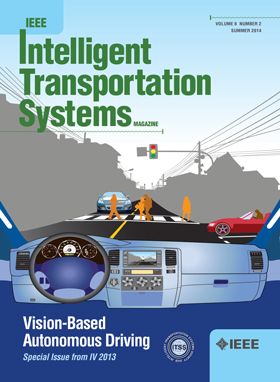AGC-ODE:用于人类移动性预测的自适应图谱控制神经 ODE
IF 7.9
1区 工程技术
Q1 ENGINEERING, CIVIL
IEEE Transactions on Intelligent Transportation Systems
Pub Date : 2024-09-05
DOI:10.1109/TITS.2024.3447161
引用次数: 0
摘要
尽管在预测人类流动性方面取得了长足进步,但大多数现有方法都无法揭示重大干预(如 COVID-19)下的时空模式,因为这些干预破坏了人类的常规流动性。为了填补这一空白,本文提出了一个统一的框架,通过对干预和干预系统进行明确建模,学习常规和干预场景下的人类移动性。具体而言,我们设计了一种名为 AGC-ODE 的新型深度状态空间模型(DSSM):AGC-ODE: Adaptive Graph Controlled Neural Ordinary Differential Equation)的新型深度状态空间模型(DSSM),用于预测 COVID-19 期间的人员流动性。描述人类移动连续时间动态的过渡方程由图控神经常微分方程参数化,指导方程传播的潜在控制通过多头门控滤波器推断。此外,还应用了信息容量约束,以促进干预的解除。最后,AGC-ODE 利用数据驱动的初始化策略来改进 DSSM 的初始状态估计。我们在北京和美国的两个真实世界数据集上进行了广泛的实验和分析,以证明我们模型的优越性和可解释性。此外,我们还介绍了基于 AGC-ODE 的已部署系统,以及该系统如何帮助在 COVID 时代防疫和在后 COVID 时代恢复工作。本文章由计算机程序翻译,如有差异,请以英文原文为准。
AGC-ODE: Adaptive Graph Controlled Neural ODE for Human Mobility Prediction
Despite the substantial progress in predicting human mobility, most existing methods fail to reveal the spatiotemporal patterns under significant interventions such as COVID-19, which disrupt the routine of human mobility. To fill this gap, this paper presents a unified framework for learning human mobility in both regular and intervened scenarios through explicit modeling of the intervention and the intervened system. To be concrete, we design a novel Deep State-Space Model (DSSM) called AGC-ODE: Adaptive Graph Controlled Neural Ordinary Differential Equation for human mobility prediction during COVID-19. The transition equation that describes continuous-time dynamics of human mobility is parameterized with a graph-controlled Neural ODE, and the latent control that guides the equation propagating is inferred through the multi-head gating filters. Additionally, an information capacity constraint is applied to foster the disentanglement of interventions. Lastly, AGC-ODE utilizes a data-driven initialization strategy to improve DSSM’s initial state estimation. We conduct extensive experiments and analysis on two real-world datasets of Beijing and the U.S. to demonstrate the superiority and interpretability of our model. Furthermore, we introduce a deployed system that is based on AGC-ODE and how it helps epidemic prevention during the COVID era and work resumption in the post-COVID era.
求助全文
通过发布文献求助,成功后即可免费获取论文全文。
去求助
来源期刊

IEEE Transactions on Intelligent Transportation Systems
工程技术-工程:电子与电气
CiteScore
14.80
自引率
12.90%
发文量
1872
审稿时长
7.5 months
期刊介绍:
The theoretical, experimental and operational aspects of electrical and electronics engineering and information technologies as applied to Intelligent Transportation Systems (ITS). Intelligent Transportation Systems are defined as those systems utilizing synergistic technologies and systems engineering concepts to develop and improve transportation systems of all kinds. The scope of this interdisciplinary activity includes the promotion, consolidation and coordination of ITS technical activities among IEEE entities, and providing a focus for cooperative activities, both internally and externally.
 求助内容:
求助内容: 应助结果提醒方式:
应助结果提醒方式:


